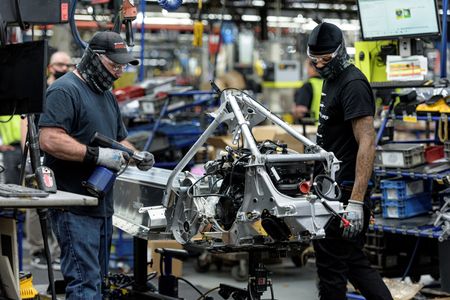WASHINGTON (Reuters) – Production at U.S. factories dropped more than expected in November as a decline in the output of motor vehicles offset gains elsewhere, according to data on Thursday, which showed manufacturing retaining some momentum.
Manufacturing output fell 0.6% last month, the Federal Reserve said on Thursday. Data for October was revised higher to show production at factories gaining 0.3% instead of the previously reported 0.1%. Economists polled by Reuters had forecast factory production would dip 0.1% last month.
Output increased 1.2% year-on-year in November.
Manufacturing, which accounts for 11.3% of the economy, is being hampered by higher borrowing costs that are dampening demand and business fixed investment. Spending is also shifting back to services while businesses are sitting on excess inventory, leaving them hesitant to place more orders with factories.
The Institute for Supply Management reported this month that its measure of national factory activity contracted in November for the first time since May 2020, when the economy was reeling from the initial wave of COVID-19 infections.
The Fed on Wednesday raised its policy rate by half a percentage point and projected at least an additional 75 basis points of increases in borrowing costs by the end of 2023. That policy rate has been raised this year from the near-zero level to the current 4.25%-4.50% range, the highest since late 2007.
Production at auto plants decreased 2.8% last month. But there were increases in the output of wood, computer and electronic products as well as aerospace and miscellaneous transportation equipment.
Mining output fell 0.7% last month, matching the decline in October. Utilities production rebounded 3.6% after three straight monthly decreases amid increased demand for heating.
That offset some of the weakness in manufacturing and mining, leading to a 0.2% drop in overall industrial production. Industrial output slipped 0.1% in October.
Capacity utilization for the manufacturing sector, a measure of how fully firms are using their resources, fell to 78.9% last month from 79.5% in October. It is 0.7 percentage point above its long-run average. Overall capacity use for the industrial sector fell 0.2 percentage point to 79.7%. It is 0.1 percentage point above its 1972-2021 average.
Officials at the U.S. central bank tend to look at capacity use measures for signals of how much “slack” remains in the economy – how far growth has room to run before it becomes inflationary.
(Reporting by Lucia Mutikani; Editing by Paul Simao)

